The latest installment of AppleInsider's comparisons between the latest iPad release and others in the product range takes a look at the earliest releases, showing how far Apple's tablet has progressed in just eight years since the first shipment of the original iPad on April 3, 2010, while still retaining the same overall appearance as its predecessors.
In an earlier post, the 2018 iPad was directly compared with some of the iPad releases from the last few years, in an attempt to suggest whether owners would benefit from upgrading to the latest version. The addition of the Apple Pencil also enabled comparisons with the current iPad Pro models, suggesting it to be a good value proposition for those who want to use the Apple Pencil without the specifications boost.
Doing a similar upgrade-centric comparison with pre-iPad Air releases would be grossly unfair due to the advancements Apple has included in the latest model. While not a heavily one-sided upgrade comparison, looking at the specifications of the first four iPad generations and the 2018 release certainly highlights the improvements Apple has put into the tablet over time, as well as what has remained the same.
External Appearance and Display
Apple has kept the screen of its main iPad line the same size throughout its lifetime, excluding the iPad mini and iPad Pro spin-offs, with that signature 9.7-inch display staying static for the last eight years.
The original iPad's resolution of 1024 by 768 pixels was used for only two device generations, switched out in the third for a 2048 by 1536-resolution panel, which has effectively stayed the same since its inclusion in 2012. The same size and resolution means the pixel density has remained at 264ppi for six years, even in the newest model.
The weight of modern iPads are fairly light compared to the earlier models, with the original weighing in at 1.5 pounds for the Wi-Fi model, 1.6 pounds with cellular. The modern model's 1.03 and 1.05 pound weights stem from Apple's push to lighten the iPad to as close to a pound as possible, instigated in the Air lineup.
The thickness has also been affected in a similar way to weight, reducing from the 13.4 millimeter thickness of the first model down to 9.4 millimeters by the fourth generation. The iPad Air and the iPad Air 2 squeezed everything down to 7.5 and 6.1 millimeters respectively, then settling back to 7.4 millimeters and 7.5 millimeters in the 2017 and 2018 releases.
Another notable thing that has remained throughout the iPad line is the use of the Home button. These early four models didn't have Touch ID, as that wasn't introduced until the iPad Air 2.
Even though the iPhone X introduced the concept of the notch and Face ID, the new iPad instead uses the well-trodden design language of the originals. To outside viewers, the 2018 iPad looks like an iPad, and that's probably what Apple wants people to think right now.
Performance
Obviously, as with other elements of computing, the iPad has improved its processing capabilities over time. While the original went with a 1GHz singe-core A4 as its processor, followed by more powerful dual-core models, these are tame compared to the 2.22GHz quad-core A10 Fusion with M10 co-processor the 2018 iPad uses.
Apple has also given the iPad more and more RAM to play with, originally offering 256MB of memory, but then doubling it and doubling it again for the next two releases until it reached 1GB, then moving to 2B from the Air 2 onwards. The current 2018 iPad has eight times the amount of memory of the original.
This all helps the 2018 iPad score multiple times higher than its predecessors in benchmarks. While the original iPad doesn't have a recorded result for this benchmark, the second-generation model mustered 356 points in single-core and 574 in multi-core tests, with the fourth-generation managing to break into four digits for multi-core testing with 1331.
The 2018 iPad by comparison achieved 3254 in its single-core tests, 9.8 times the second-generation iPad's score. It's a similar story for multi-core performance, with its recorded 5857 equating to over ten times the score achieved by the seven-year-old model.
Imaging
The original iPad didn't have any cameras at all, but Apple included the FaceTime and rear cameras in the second-gen model. Even so, these were not entirely great imaging components, with the rear capable of 0.7-megapixel still images and a 720p video, while the front used a 0.3-megapixel sensor.
In the third generation, Apple switched out the rear camera for a 5-megapixel sensor, kept in the product line until the iPad Air 2, which switched it out for an 8-megapixel model that is still being used today. From the third-generation, the rear camera has been able to record 1080p video, but while the iPad Pro and iPhones are now able to capture 4K footage, this has yet to be enabled on iPads.
The front camera went through a similar transformation, but slightly delayed. The 0.3-megapixel camera remained until the 1.2-megapixel version in the fourth-generation model, which also allowed for recording 720p video, the feature again remaining to this day without any further improvement.
Connectivity and Miscellaneous
The technology that drives Wi-Fi in the iPads has gone through only a few changes over its lifetime, partly due to its overall slow turnover to newer protocols. The original started off with 802.11n support, but didn't step up to 802.11ac until the iPad Air 2.
Bluetooth connectivity has also jumped in stages, with the first two models supporting Bluetooth 2.1+EDR (Enhanced Data Rate,) followed by 4.0 support in the third and fourth. The current models include support for Bluetooth 4.2.
One change that has stayed with the iPad for a long time is the Lightning port, which replaced the 30-pin connector used in the first three iPad generations. It also wasn't until the first iPad Air that Apple included two speakers in the iPad line, meaning that earlier models had to abide by a single speaker.
Notably battery power for the latest model isn't that high when compared to earlier releases. The third and fourth-generation iPads had 43 Watt Hour batteries, approximately a third higher in terms of capacity than the latest iPad's 32.4 Watt hour version.
Another unexpected oddity is the way that storage capacities have stayed relatively unchanged over time. While the 16GB option has disappeared along with 64GB, the 32GB capacity has always been available since the original iPad, while the 128GB capacity existed since the fourth-generation.
Three storage capacities were available at first, expanding to four by the fourth generation, but now there are only two size options to choose from in the latest iPad model.
Moore's Law is dead on the desktop, but not the tablet
As said earlier, there is no point in suggesting it is worth upgrading to the newest model, as it is certainly going to be more powerful and generally better to use in terms of specification compared to initial iPads. There are also reasons to keep hold of the original iPads instead of making the move, such as app compatibility with older iOS versions that are not usable on newer models, or plain old sentimentality.
There are, however, two takeaways to consider in this comparison: improvements and static specifications.
In seven years the iPad has improved its processing power tenfold, with it also having eight times the RAM and double the pixel density of the original release. These are massive improvements over time, and are likely to improve further as Apple continues to refine the design.
For areas that have remained the same, these too fall into two camps. Components like the camera and battery receive improvements from time to time, and it's entirely possible for newer versions of these, and even the display, to be introduced in future models.
As for areas like the screen size and thinness, these will probably remain core tenets in Apple's design philosophy for the foreseeable future. Apple wants its products to be recognizable by everyone, and sticking to the same basic principles of a specific-sized display with a home button and a thin body for a long period of time certainly helps people tell if a device is an iPad, even eight years down the line.
 Malcolm Owen
Malcolm Owen
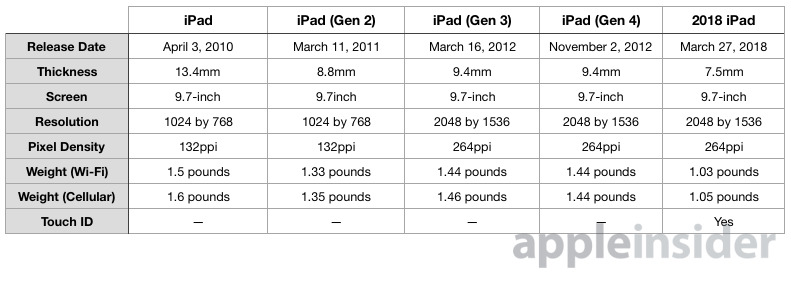
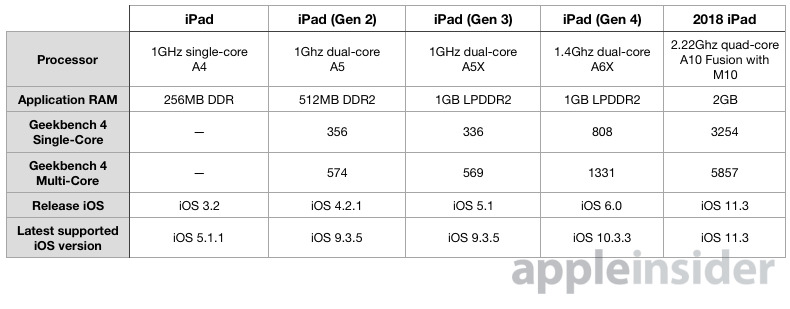

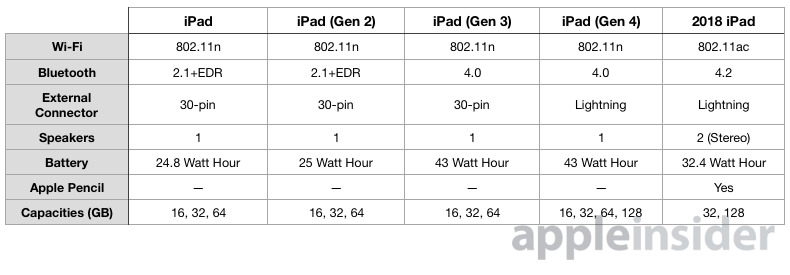
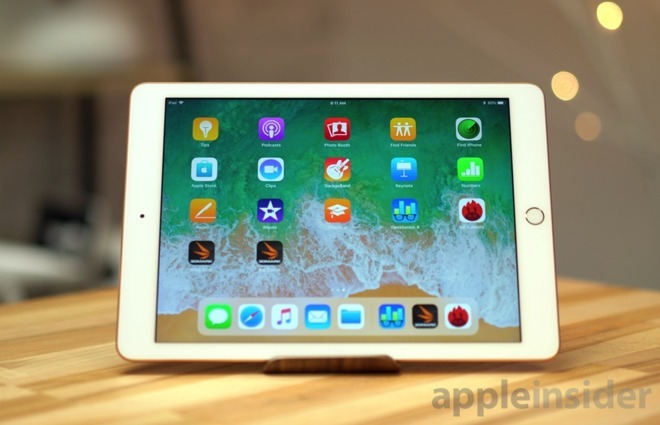




-xl-m.jpg)


-m.jpg)






 Amber Neely
Amber Neely
 William Gallagher
William Gallagher


 Mike Wuerthele
Mike Wuerthele


 Thomas Sibilly
Thomas Sibilly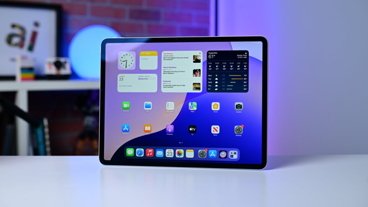








7 Comments
Perfect time to upgrade my 3rd gen which suddenly died a week ago.
I remember watching Steve demo this in his armchair. I instantly told myself, "yeah, I gotta have one of these." I got one on launch day. Traded it up for an iPad 2, that got traded up for an iPad mini that I use daily. My wife loves her iPad Pro, and the old iPad 2 is still in use by a family member. These things last and stay viable for many uses.
The recent news item on Apple making its own chips makes me wonder if we will see an iOS emulator on MacOS. Be kinda useful to see a window of my iOS devices on my mac so as to be able to exchange content or see it formatted as it will appear on the other device.
A thought about TouchID vs. FaceID: iPhones are very personal and each person has his/her own while iPads are shared somewhat more often. TouchID allows multiple users while FaceID is limited to exactly one. Perhaps that's part of the reason iPads have stayed with TouchID? Cost is also a factor I suspect.
The only time I ever felt burned by buying an Apple product was with the iPad 3. Less than 6 months after its release out came the vastly superior iPad 4 with a CPU that would drive the retina display for a good few iOS cycles, unlike the lemon I bought that became practically unusable with iOS 7.